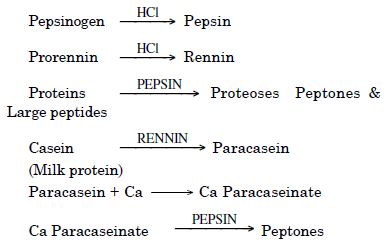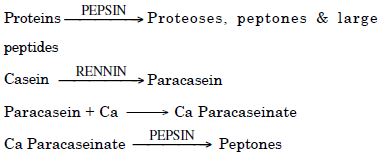Get free NCERT Solutions at Aasoka for the chapter “Digestion and Absorption”. These solutions are written in an easy-to-understand language keeping the latest CBSE syllabus in mind. NCERT Solutions for Class 11 helps students in studying, understanding, and learning the concepts effectively. Along with this, students can also learn time management to perform better in their exams.
In the chapter “Digestion and Absorption” of Biology Class 11, students will learn their body function, food digestion and absorption, major components of food, nutritional components of a daily diet, problems faced in case of deficiency of nutrition, digestive system disorders, human physiology, and much more.
Question 1:
Choose the correct answer among the following :—
(a) Gastric juice contains :
- pepsin, lipase and rennin.
- trypsin, lipase and rennin.
- trypsin, pepsin and lipase.
- trypsin, pepsin and rennin.
(b) Succus entericus is the name given to :
- a junction between ileum and large intestine.
- intestinal juice.
- swelling in the gut.
- appendix.
Answer:
(a) Gastric juice contains :
(i) pepsin, lipase and rennin.
(b) Succus entericus is the name given to :
(ii) intestinal juice.
Question 2:
Match the question.
Answer:
1. (b) 2. (d) 3. (c) 4. (a)
Question 3:
Answer briefly :
- Why are villi present in the intestine and not in the stomach ?
- How does pepsinogen change into its active form ?
- How does bile help in the digestion of fats ?
Answer:
(a) Villi increase the surface area for absorption of digested food. As the main site for absorption is the intestine and minor absorption occurs in the stomach, so the villi are confined to the intestine.
(b) HCl activates pepsinogen to pepsin, since pepsin is formed it activates rest of pepsinogen (propepsin) to active pepsin and this process is called autocatalysis.
(c) Role of bile in the digestion of food.
1. Bile salts such as sodium glycocholate and sodium taurocholate reduce the surface tension of fat droplets causing their breakdown into small ones. Thus fats are emulsified.
2. Bile salts such as sodium carbonate help in digestion by providing alkaline medium necessary for action of lipase.
3. It helps in the absorption of end products of fats by forming water soluble micelles.
Question 4:
State the role of pancreatic juice in the digestion of proteins.
Answer:
Pancreatic juice contains proenzymes–trypsinogen, chymotryp-sinogen and procar- boxypeptidase which get activated to trypsin, chymotrypsin and carboxypeptidase respectively. All these are concerned with protein digestion.
Question 5:
Describe the process of digestion of protein in stomach.
Answer:
The gastric juice has several protein digesting enzymes present in their inactive forms which are activated by HCl.
Question 6:
Give the dental formula of human beings.
Answer:
Question 7:
Bile juice contains no digestive enzymes, yet it is important for digestion. Why ?
Answer:
Function of bile. Bile juice performs the following functions :
- It helps in the absorption of fat due to the presence of bile salts.
- The bile salts emulsify the fats.
- It helps in excretion of cholesterol, inorganic salts, toxins and bile pigments.
- It neutralises the acidity of gastric juice.
- Bile salts activate pancreatic lipase.
- It stimulates peristalsis movement and laxative.
- It assists in the liberation of secretin.
- It helps to absorb vitamin K and fat soluble vitamins such as A, D and E.
Question 8:
Describe the digestive role of chymotrypsin. Which two other digestive enzymes of the same category are secreted by its source gland ?
Answer:
Chymotrypsin is a protein digesting enzyme secreted by pancreas. It cleaves proteins into large peptides.
The two other digestive enzymes of the same category secreted by pancrease are – Trypsin and Carboxypeptidase.
Question 9:
How are polysaccharides and disaccharides digested ?
Answer:
- Salivary amylase (Ptyalin) enzyme present in saliva hydrolyses about 30% of starch to the disaccharides maltose and isomaltose and small dextrin called ‘limit’ dextrin.
- As gastric juice lacks carbohydrate digesting enzyme hence no digestion takes place in stomach.
- Pancreatic amylase digest starch into maltose, isomaltose and limit dextrins in the intestine in alkaline medium.
- Enzymes isomaltase, maltase present in the intestinal juice further hydrolyse maltose, isomaltose and limit dextrins to glucose (diffusible form).
Sucrase enzyme acts upon sucrose to form glucose and fructose. Similarly lactase acts upon lactose (milk sugar) to form glucose and glactose.
Question 10:
What would happen if HCl is not secreted in the stomach ?
Answer:
If HCl is not secreted in the stomach, then the following important functions being performed by it would not have occurred and helped in normal functioning of digestive system.
Functions of HCl :
- It activates proenzyme pepsinogen into active pepsin.
- It provides acidic medium in stomach necessary for action of pepsin.
- It kills harmful bacteria which find entry along with food. So we can say that HCl is responsible for carrying out many important functions in the body. It plays a significant role in digestion of food as well as acts as bactericidal.
Question 11:
How does butter in your food get digested and absorbed in the body ? Explain in detail.
Answer:
Butter is a type of fat which is digested by enzymes called as lipases.
The gastric juice contains gastric lipase which converts fat into monoglycerides and fatty acids.
Bile juice causes emulsification of fats. The emulsified fat is acted upon by pancreatic lipase to cause its digestion into end products i.e. fatty acid and glycerol.
Since fatty acids and glycerol are insoluble in water, so they cannot be absorbed directly. They are first incorporated into small, spherical, water soluble droplets called micelles from which they get absorbed into the intestinal cells by diffusion.
Question 12:
Discuss the main steps in digestion of proteins as the food passes through different parts of the alimentary canal.
Answer:
Digestion of proteins. There is no protein digesting enzyme in the saliva, so no digestion takes place in the oral cavity.
In the stomach, inactive enzymes-pepsinogen and prorennin get activated to pepsin and rennin respectively under the action of HCl.
In the small intestine, there is digestion of proteins under the action of enzymes of pancreatic juice.
Question 13:
Explain the term thecodont and diphyodont.
Answer:
Thecodont. The roots of teeth are lodged in sockets of bones, such teeth are termed thecodont teeth.
Diphyodont. Man has two sets of teeth during life time, milk teeth and permanent teeth, such a dentition is termed diphyodont.
Question 14:
Name different types of teeth and their number in an adult human.
Answer:
Types of Teeth.
Incisors 4 pairs.
Canines 2 pairs.
Premolars 4 pairs.
Molars 6 pairs.
Question 15:
What are the functions of liver ?
Answer:
Functions of liver
- Secretion of bile for emulsification of fats.
- Regulation of blood sugar level by striking a balance between glycogenesis and glycogenolysis.
- It changes haemoglobin of dead RBCs into bile pigments like bilirubin and biliverdin.
- Formation of RBCs during embryonic life.





